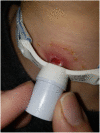Utility of telemedicine in tracheostomy-dependent children
- PMID: 36544973
- PMCID: PMC9764762
- DOI: 10.1002/lio2.937
Utility of telemedicine in tracheostomy-dependent children
Abstract
Objectives: Telemedicine can improve access to pediatric otolaryngology care by decreasing travel time and cost, and lowering the risk of viral transmission during the SARS-CoV-2 (COVID-19) pandemic. This study aims to identify the clinical role and outcomes of telemedicine for tracheostomy-dependent children before and during the COVID-19 pandemic.
Methods: Retrospective chart review of 42 tracheostomy-dependent pediatric patients who utilized telemedicine between October 2013 and April 2020 (pre-COVID-19), and 111 patients who utilized telemedicine between May 2020 and July 2021 (during COVID-19) at a tertiary free-standing children's hospital outpatient clinic.
Results: The majority of pre-COVID-19 telecommunication solely addressed tracheostomy stomal concerns as compared with during COVID-19 (99% vs. 3%, p < .001), while telecommunication during COVID-19 was mainly used for routine follow-up as compared with pre-COVID-19 (99% vs. 0%, p < .001). Telemedicine visits during COVID-19 were significantly less likely to result in the need for in-person office visits as compared with those pre-COVID-19 (4% vs. 22%; p < .001). There was no significant difference in urgent emergency department (ED) evaluation following telemedicine pre- and during COVID-19 (16% vs. 11%). The most common reasons for ED presentation both pre- and during COVID-19 following telemedicine visit included respiratory distress, dislodged tracheostomy tube, and tracheostomy bleeding.
Conclusion: The clinical role of telemedicine has evolved from problem-based evaluation to routine follow-up during the COVID-19 pandemic. Although telemedicine can decrease the need for in-person office evaluation of routine tracheostomy concerns, respiratory complications and tracheostomy bleeding still require urgent in-person ED evaluation.
Level of evidence: Level 4.
Keywords: COVID‐19; pediatric otolaryngology; telemedicine; tracheostomy.
© 2022 The Authors. Laryngoscope Investigative Otolaryngology published by Wiley Periodicals LLC on behalf of The Triological Society.
Conflict of interest statement
The authors have no funding or conflicts of interest to report.
Figures

References
LinkOut - more resources
Full Text Sources
Research Materials
Miscellaneous
